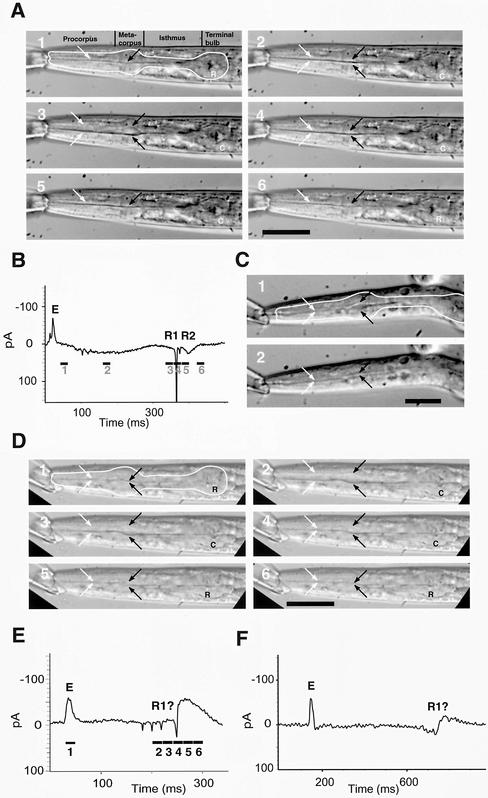Figure 5.
Repolarization and relaxation of corpus muscles is desynchronized in the inx-6(rr5) mutant. (A and B) Video and EPG, respectively, of wild-type L3 larva. In all frames, the white arrows indicate the position of the lumenal walls in the procorpus and the black arrows indicate the position of the lumenal walls in the metacorpus. In the first frame, the outline of the pharynx is traced in white. In the terminal bulb (TB) a C indicates that the TB muscles are contracted and an R indicates they are relaxed. The period of time over which each video image was captured is indicated by a black bar under the EPG trace with the video frame number corresponding to that time point indicated below the bar. E marks the excitation spike that signals the beginning of the action potential and R1 and R2 mark the repolarization of the corpus and terminal bulb muscle, respectively. In frame 1, depolarization has occurred but there is almost no contraction of the corpus or terminal bulb. In frame 2, the terminal bulb is contracted but the corpus contraction is modest. In frame 3, the corpus reaches maximal contraction just before repolarization. In frame 4, the corpus muscle repolarizes and relaxes almost simultaneously although relaxation is not quite complete. In frame 5, the terminal bulb has repolarized but is still contracted. In frame 6, all muscles are relaxed. Bar, 50 μm. (C) L3 inx-6(rr5) that escaped the restrictive temperature. In frame 1, the metacorpus has reached the point of maximum contraction during the pump but the procorpus is still relaxed. In comparison, frame 2 shows complete relaxation of the pharyngeal muscle during an interpump interval. Bar, 25 μm. (D and E) Video and EPG of a 3-d-old L4 inx-6(rr5); avr-15(ad1051) mutant worm that escaped the restrictive temperature. The E spike(s) is broadened and there are four downward spikes in spite of the absence of M3 neurotransmission as a result of the avr-25(ad1051) mutation. Frame 1, the pharynx just before contraction begins. All muscles are fully relaxed. Frame 2, all muscles are at their point of maximum contraction indicated by the wide-open lumen. Frame 3, the procorpus muscle, and to a lesser extent, the metacorpus muscles, have begun to relax and the lumen is more constricted. Frame 4, the procorpus muscles have relaxed but the metacorpus is still mostly contracted. Frame 5, the terminal bulb has now relaxed but the metacorpus is still slightly open. Frame 6, all of the muscles are completely relaxed. Bar, 50 μm. (F) EPG trace of inx-6(rr5); exp-2(ad1426) avr-15(ad1051) that escaped restrictive temperature. The exp-2(ad1426) mutation eliminates the potassium channel that mediates fast muscle repolarization and hence the R spikes. With exp-2(ad1426) in the background, there are no R spikes, only a slow wave indicating the repolarization.

